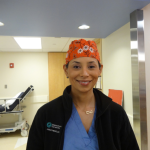Mass Eye and Ear is pushing the bounds of discovery in dystonia research, utilizing artificial intelligence to diagnose and treat patients more accurately and timely. Watch this video from the 2023 Sense-ation! Gala to learn more about this research and hear one patient’s moving story.
Imagine slowly losing your most valuable tool for communication, your voice, without any discernible cause. Not long ago, Bobbi Richardson experienced this. She noticed her voice sounding extremely strained and gargled, and talking became an exhausting effort.
Receiving an unexpected diagnosis of laryngeal dystonia (previously known as spasmodic dysphonia) – a neurological condition that involuntarily contracts the vocal cords, leading to severe speech difficulties – the sound of her voice she knew well, had disappeared.
Laryngeal dystonia is a subtype of dystonia, a debilitating neurological movement disorder that causes involuntary muscle spasms in different parts of the body.
After the diagnosis, she was directed to Mass Eye and Ear, where she received proper treatment through the care of Phillip Song, MD, director of the Laryngology Division at Mass Eye and Ear.
Additionally, she and her husband, Keith, were introduced to Kristina Simonyan, MD, PhD, Dr med, director of Laryngology Research at Mass Eye and Ear. Dr. Simonyan shared her ongoing research with the Richardsons, focused on improving diagnostic accuracy and expanding treatment options for dystonia patients through artificial intelligence (AI).
Dystonia: The Unknown
Dystonia is traditionally hard to diagnose. Due to its wide-ranging symptoms, from whole-body twisting to difficulty speaking, dystonia can be easily misdiagnosed as another neurological condition.
The lack of specific diagnostic testing capabilities often leads physicians to rely on the process of elimination when a patient presents with these symptoms, ruling out dozens of similar conditions before arriving at a dystonia diagnosis. On average, diagnosing dystonia can take five to ten years.
Not only does this prevent patients from getting the appropriate care and treatment, but it also contributes to diminished quality of life.
The primary treatment option for dystonia is botulinum toxin (Botox) injections into the affected muscles. However, the injections do not work for every patient, and there has been no established way for clinicians to determine who would benefit and who would not prior to treatment initiation.
Bobbi originally received Botox injections into her vocal cords to manage symptoms of laryngeal dystonia. However, the treatment benefits were not sufficient, which prompted Dr. Song to modify the injecting approach to deliver significantly better and more consistent outcomes. “I am grateful Mass Eye and Ear found a treatment that works for me, but it’s unsettling to know how many patients worldwide live with their symptoms without effective treatments,” Bobbi shared.
This urgent need to develop objective methods for diagnosing and treating dystonia has motivated Dr. Simonyan and her team to leverage AI to create DystoniaNet and DystoniaBoTXNet platforms. These new tools are the first technologies of their kind to enable fast and accurate diagnosis of dystonia and predict who might benefit from Botox injections.

“We want patients to receive an accurate diagnosis and proper treatment as quickly as possible after their symptoms onset,” shared Dr. Simonyan. “The present-day capabilities of AI algorithms enabled us to develop and implement the DystoniaNet and DystoniaBoTXNet platform, which are likely to advance our clinical management of patients with dystonia.”
Leveraging AI for Dystonia Care
Both algorithms use deep learning, a specific type of AI algorithm, to automatically analyze data from individual MRIs and identify subtle differences in brain structure that can be used for diagnosis of the disorder and the predictive assessment of treatment outcomes.
Confirming DystoniaNet’s efficacy, Dr. Simonyan and her colleagues showed in a 2020 study that the platform was able to diagnose dystonia with an average accuracy of 98.8 percent in less than one second using the brain MRI scan of patients with different forms of dystonia. Within this group, 220 patients had laryngeal dystonia and they were diagnosed with a 96.2 percent accuracy. This study revealed a new microstructural neural network biomarker that is used by DystoniaNet to deliver its automated diagnosis. This exciting research established that DystoniaNet is a promising tool that can provide an accurate, objective and quick diagnosis of dystonia.
Dr. Simonyan and her team did not stop there. They created DystoniaBoTXNet, another deep-learning algorithm to predict whether an individual with dystonia will respond to Botox based on input from a brain MRI.
In a 2022 study, the research team developed DystoniaBoTXNet to analyze the brain MRIs of patients with four types of dystonia who responded and did not respond to Botox injections. DystoniaBoTXNet achieved an overall accuracy of 96.3 percent in predicting Botox efficacy, with 100 percent sensitivity and 86.1 percent specificity. The average computational time of DystoniaBoTXNet was 19.2 seconds per case.
These remarkable findings suggest that DystoniaBoTXNet can effectively assist in selecting candidates for the initial Botox treatment and refine decision-making regarding additional injection cycles in cases where patients do not respond to the first injection.
Together, these groundbreaking studies offer hope for dystonia patients worldwide. “This research journey has been truly exhilarating, revealing the positive aspects of AI that can contribute to better care for dystonia patients,” said Dr. Simonyan.
Making Life-Saving Work Possible

Since 2019, Bobbi and Keith Richardson have been philanthropically fueling Dr. Simonyan’s dystonia research. Giving year after year, Dr. Simonyan was able to leverage their generous gifts to build the framework of this AI-powered clinical research program and secure additional federal funds, enabling her and her team to refine both the DystoniaNet and DystoniaBoTXNet platform and test them in a clinical setting.
“I know firsthand the feeling of being a dystonia patient, the symptoms we endure are undeniably distressing,” Bobbi told Focus. “Knowing that Dr. Simonyan’s research will have this far-reaching impact on the dystonia community makes me beyond proud. My husband and I are so happy we can be part of this.”



